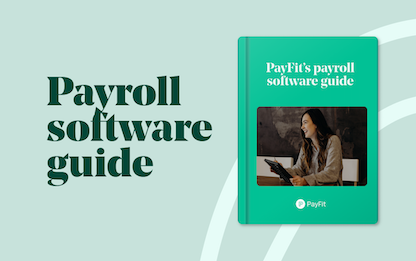- Blog
- |Managing Payroll
- >Finance
- >employee turnover costs
The True Cost of Employee Turnover from Hiring to Productivity and Beyond


The true cost of employee turnover can be hard to define. For one, this figure can encompass much more than just recruitment expenses. There are other expenses to be incurred in the training, onboarding and development of new employees.
Then there are the costs that seem more ‘invisible’, but that are clearly there - such as the loss of productivity or reputational damage that follows a big churn of staff.
All of this makes the cost of employee turnover here in the UK a challenging aspect of doing business. So let’s take a no-holds-barred deep dive into all these costs and expenses and what they can mean for your company.
Employee turnover unpacked
Employees leave jobs: it’s an inevitable fact of doing business. But when that churn starts to rise, loss of money and time can creep up, too.
The meaning of employee turnover can be summed up as the number of employees who leave your organisation over a specific time period (here’s how to calculate employee turnover). Turnover can be either voluntary or involuntary - such as staff members being laid off or terminated - and can lead to either internal or external candidates replacing team members who’ve left.
It’s important to remember not all employee turnover is bad. Some of it is perfectly normal and can also have a positive impact on your business, like allowing team members who have outgrown your company to move on and fresh talent to cycle in.
The problems start when turnover begins to rise unnaturally as a result of organisational issues; in other words, it becomes dysfunctional employee turnover. Hiring and re-training costs can then spike up in tandem. Currently, the average cost of replacing an employee in the UK is around £25,000 per worker, which accounts for rehiring and lost productivity. For specialist and senior roles, this number can range higher, think £40,000 to £100,000 per head.
What is the average employee turnover rate in the UK?
According to a labour turnover report from Cendex, the voluntary turnover rate for 2023 was 13.8% alone across UK businesses. That means roughly 1 in 7 employees resigned or quit last year. And this still doesn’t account for churn related to layoffs and terminations.
But why is employee turnover a bad thing?
The financial costs we’re alluding to make unnatural turnover bad enough. But there are other negative impacts we can associate with turnover as well that could cost your organisation dearly. These may not appear as line items on your company ledger, but they can destabilise any organisation.
So, what are the negative effects of employee turnover? For one, turnover can make it difficult to retain top talent, who may be ‘turned off’ from a constant ‘chop and change’ work environment or the departure of respected colleagues. Quality control can also wane as new employees try to get to grips with unfamiliar systems and processes, leading to an uptick in mistakes and errors. Customer service is one area that can suffer in particular as new hires take time to become sufficiently knowledgeable about products and services.
Then, there’s the question of employee morale and engagement. Burnout is a particularly dangerous cost of employee turnover as the negative effects of this can start to snowball. Resignations and quitting mean remaining employees become saddled with more work, which in turn can lead to those team members leaving.
6 Real Costs of Employee Turnover
So, what are the actual costs of employee turnover in the UK? It can be hard to pin down every single one of these as some costs will be ‘harder’ and more definable than others. But if we look at what happens right after an employee leaves and what needs to occur to replace them, we can start to map some of these out.
In this section, we’ll look at what makes employee turnover expensive and some real examples of turnover costs, such as hiring, re-training and onboarding new employees.
Hiring new employees
Possibly, the most obvious cost is having to re-hire for the vacated position. And according to Glassdoor, this isn’t cheap - the average cost-per-hire for employers is about £3,000 per employee.
When we say ‘cost-per-hire’, we’re talking about all those cumulative expenses involved in attracting and vetting a potential new hire, things like advertising banners, pay-per-click ads and job site postings.
And if the position is ultra-specialised, these costs can rise even more, especially if you need to engage a top headhunter. In fact, most recruiters will charge 20-30% of the final salary offered. Throw in all the time you’ll need to spend interviewing and testing candidates, and you could be faced with quite a hefty sum at the end of your search.
Engaging temporary workers or resolving to overtime
Then there are all the ‘hard’ costs of losing a key hire. When an employee leaves, it can often create a void in the business, especially if their role is critical to operations. You might have to splash additional budget on hiring a temporary worker so you ensure the job still gets done or pay other team members overtime to fill the gap.
As we touched on briefly before, this last option can result in more than just money going down the drain. If team members have to work longer hours to make up for a shortfall, this can lead to burnout and even higher turnover rates.
Onboarding the successful candidates
Once you’ve made an offer and it’s been accepted, you might breathe a sigh of relief: finally, the drain of employee turnover costs on my company should stop. But think again. In theory, you should be able to just get on with business as usual. But onboarding is a vital part of any hiring process and is critical if you want to avoid a repeat of last time.
There are more practical onboarding costs to consider, such as the paperwork, insurance, taxes, and payroll. And then there are the additional costs to help your new employee feel settled, such as new tools, equipment, and even new devices such as laptops.
Given this, you might be tempted to simply glaze over the onboarding process, but this could be detrimental to your business and lead to turnover all over again.
Training costs
It’s no secret that training a new employee can be expensive. This is especially true if the role is specialised. It might be that your new hire needs to learn how to use a particular piece of technology to perform their duties. Or they may need to take a course or become qualified in a specific skill set.
There are also other ancillary costs to consider, like the shipping of materials or installation of new technology and equipment. While minor, these can add up, especially if you have multiple new employees to retrain.
Lost productivity
Along with the ‘harder’ costs, employee turnover can trigger ‘softer’ costs. While harder to define, these can still take their toll on efficiency within your business. It takes almost 28 days to fill a position.
In the meantime, the existing team will have to work out how they can tackle the shortfall. And this is where productivity can start to shift. If it takes seven people an hour to bake 70 cakes, then how many cakes can a team of six complete in this same timeframe? It’s a type of maths problem we’re all familiar with from our school days (that is, if we were paying attention at all!) but which suddenly becomes very real in the world of business.
With fewer employees, your team may not be able to perform as efficiently as they used to. This means that in the productivity equation, something will have to give: either it will be quality, volume or time. In the end, there is no getting away from it - productivity has to suffer.
Damage to reputation
Reputational damage can take many forms. To start with, customers may become exasperated with your brand due to slower or insufficient response times or delays in resolving their issues. Then, there’s the general perception of your brand from a wider audience, whether that’s a concern about the quality of your product and service or its ethics, where corners are being cut to meet quotas.
The problem is the outside customer can’t see what’s going on internally with your business. They can’t see the overworked staff working across double the accounts or the struggle to re-hire in the wake of churn. All they see is a company that no longer meets their expectations. So, the image that forms in their mind is one of crisis instead of confidence. In this way, high employee turnover can lead to reputational damage, even if it’s not entirely deserved.
What can your company do?
Reducing employee turnover isn’t easy, especially if it comes from a place of deep-seated organisational issues that are hard to shift. But there are a few initial actions you can take to try and slow the churn. They are:
Bolster your employer brand - Establish one that feels authentic and consistent; then, this can go a long way in reducing reputational damage and attracting better candidates within the marketplace.
Improve your onboarding process - If you don’t already have one in place, then develop an onboarding program that’s effective and straightforward for new hires to follow.
Promote and replace from within - Giving your employees the opportunity to grow and progress with your company isn’t just a win-win, it can also allow you to save a lot of the costs associated with turnover such as recruiting and training.
Make things better with technology - Just like customers, employees enjoy experiences that are intuitive, simple and seamless. You can leverage technology like automation to enhance productivity and, in doing so, foster more creative and strategic thinking.


UK Expenses Management - A Guide For Employers

Overtime Pay Rates & Laws in the UK

The 2024 UK National Living Wage - An Employer’s Guide

The Cost Of Recruitment In The UK - What You Might Not Know

UK National Insurance Changes for January 2024


